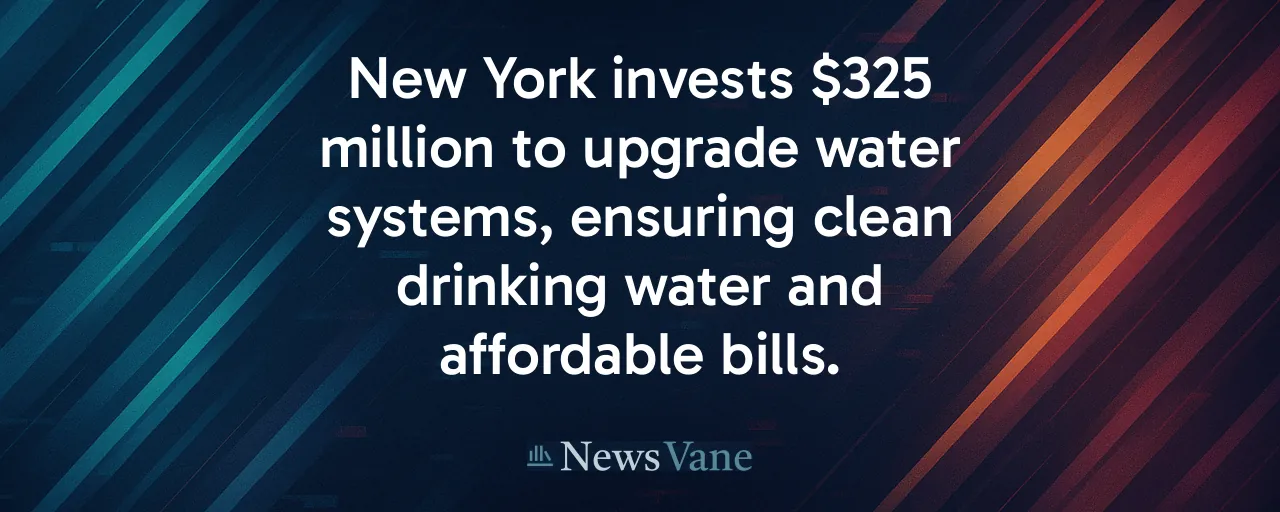A Turning Point for New York's Water Systems
Clean water flows through the heart of every community. In New York, where old pipes leak and chemicals like PFAS lurk in drinking water, the state is rolling out $325 million in grants to fix aging infrastructure. This funding, announced by the governor's office, targets everything from lead pipes to sewage systems, aiming to protect public health, spark jobs, and keep bills affordable for residents.
The timing feels urgent. Across the country, water systems are buckling under pipes laid decades ago, with 240,000 breaks each year and a $625 billion repair bill looming over the next two decades. New York's move signals a commitment to tackle these issues head-on, offering a model for others to follow.
Beyond technical fixes, this effort ensures families can trust their tap water, businesses can operate without disruptions, and small towns aren't left behind. The plan invites a closer look at how targeted investment can reshape communities for the better.
Breaking Down the Grant Program
Managed by the New York State Environmental Facilities Corporation, the $325 million will fund projects like replacing lead service lines, upgrading wastewater plants, and installing filters to remove PFAS, a harmful chemical group. Municipalities can apply starting June 20, with a September 12 deadline.
PFAS treatment is a priority. Projects tackling water systems with PFAS above state limits can get up to 70 percent of costs covered, a lifeline for communities grappling with contamination. Rural towns, often stretched thin financially, will see grants jump from 25 percent to 50 percent of project costs, easing pressure on local budgets.
Collaboration is also key. The program supports shared infrastructure projects between towns, like joint water treatment systems, to save money and boost efficiency. These efforts aim to deliver lasting improvements while addressing urgent needs.
The Stakes: Health, Jobs, and Fairness
Old water systems carry serious risks. Leaky pipes waste treated water, and contaminants like lead or PFAS threaten health, as seen in crises in Flint, Michigan, and Jackson, Mississippi. These failures often hit hardest in underserved areas, deepening inequities.
The economic upside is just as significant. Infrastructure work fuels jobs in construction, engineering, and manufacturing, employing thousands statewide. Studies suggest closing the national water funding gap could add $4.5 trillion to GDP and 800,000 jobs long-term. New York's grants are a piece of that puzzle, driving local growth.
Fairness matters too. Small and rural communities struggle to fund upgrades, which can spike utility bills for low-income families. By boosting grants and providing technical help, New York seeks to ensure clean water reaches all residents, especially those who might otherwise struggle with affordability.
Weighing Different Views on Funding
Approaches to water infrastructure vary. Some emphasize local control, arguing that towns know their needs best and should face fewer regulatory hurdles. They also push for industries, like those producing PFAS, to foot cleanup bills to spare taxpayers.
Others call for bigger investments, citing a $91 billion national funding gap. They view clean water as a right and advocate for federal aid, like a permanent program to help low-income households with water bills, to prevent rate hikes from burdening families. Both perspectives highlight the need for action but differ on scope.
New York's strategy blends these ideas. It pairs state grants with federal funds from the 2021 Bipartisan Infrastructure Law to stretch dollars further. With $6 billion invested since 2017, the state is making progress, though long-term funding questions linger.
What's Next: Opportunities and Hurdles
Challenges remain. Upgrading pipes and treating PFAS is expensive, and even with grants, towns must cover some costs. Water bills nationwide have climbed 64 percent since 2012, and 12 to 19 million households struggle to pay. New York's focus on affordability helps, but sustained funding is critical to avoid passing costs to residents.
The potential is undeniable. Modern water systems can safeguard health, drive economic growth, and prepare communities for climate challenges like floods or droughts. By prioritizing rural areas and contaminants, New York addresses both today's problems and tomorrow's risks.
As towns prepare applications, New Yorkers are watching closely. This $325 million represents a promise of cleaner water and stronger communities. Whether it meets the full scope of the challenge is uncertain, but it marks a meaningful stride toward a safer, healthier future.
